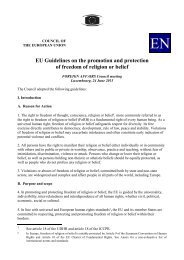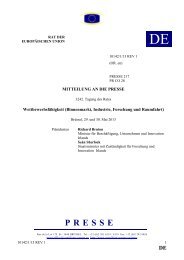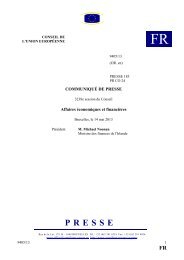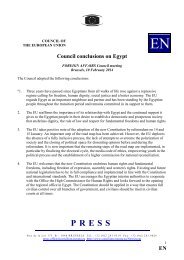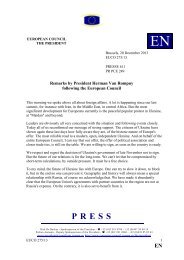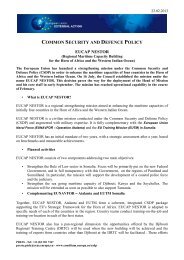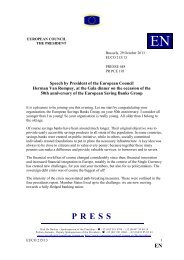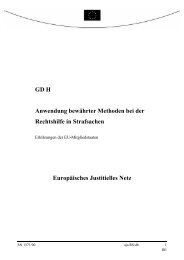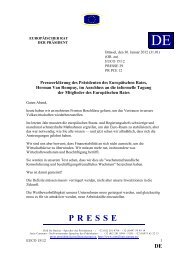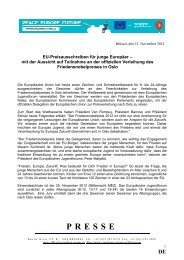14508/09 ADD 1 PL/vk 1 DG G COUNCIL OF THE ... - Europa
14508/09 ADD 1 PL/vk 1 DG G COUNCIL OF THE ... - Europa
14508/09 ADD 1 PL/vk 1 DG G COUNCIL OF THE ... - Europa
Create successful ePaper yourself
Turn your PDF publications into a flip-book with our unique Google optimized e-Paper software.
Unemployment has been falling in most countries between 2000 and 2007 for both women and<br />
men. Gender gaps in unemployment rates have also been narrowing, by 0.8 percent in EU27. The<br />
main exceptions to this pattern are Lithuania, Slovakia and Hungary, where the gender gaps have<br />
widened by 2 percent or more. On the other hand, in Spain, Cyprus, Italy, Poland, France and<br />
Greece the gap has closed by more than 2 percent.<br />
Indicator 10: The most reliable harmonised gender pay gap data are based on the Structure of<br />
Earnings Survey (SES). 32 The gender pay gap in unadjusted form represents the difference between<br />
average gross hourly earnings of male paid employees and those of female paid employees as a<br />
percentage of average gross hourly earnings of male employees. It is not possible to portray this<br />
indicator fully since at present no data are available by education and sector and the age<br />
categorisation is not asked for.<br />
At EU27 level, the gender pay gap was slightly more than 17 % in 2007. For women there is a<br />
negative gender pay gap in all countries. The largest gap is found in Estonia (30 %), the smallest in<br />
Italy (4 %). Some countries seem not to be doing very well on this indicator, since the gap is 20 %<br />
or more (FI, LT, EL, UK, DE, CY, NL, SK, CZ, AT, EE); others score better with gaps of less than<br />
10 % (IT, MT, <strong>PL</strong>, PT, SI, BE).<br />
However, a narrow gender pay gap may not mean a better labour market situation for women than a<br />
larger gender pay gap (OECD 2002). The reason for this is that highly educated and better paid<br />
women are to a great extent employed in almost all countries. This is not the case with women with<br />
lower education and less pay. The differences between countries are much greater in the latter<br />
category; in some countries the employment rate is relatively high, while in others it is quite low.<br />
32 The unadjusted gender pay gap represents the difference between average gross hourly<br />
earnings of male paid employees and those of female paid employees. From 2006 onwards,<br />
the GPG data is based on the methodology of the Structure of Earnings Survey (SES) carried<br />
out with a four-yearly periodicity. The most recent available reference years are 2002 and<br />
2006 and Eurostat computed the GPG for these years on this basis. For the intermediate years<br />
(2007 onwards) countries provide Eurostat with estimates benchmarked on the SES results.<br />
Target population is all employees without restrictions as far as age and hours worked are<br />
concerned, but only enterprises with 10 employees or more are included. In accordance with<br />
NACE Rev. 1.1. economic activities are included for the aggregate sections C-O, excluding L,<br />
which means that A. Agriculture, hunting and forestry; B Fishing; L Public administration and<br />
defence, compulsory social security; P Activities of households and Q Extraterritorial<br />
organisations and bodies are excluded.<br />
<strong>14508</strong>/<strong>09</strong> <strong>ADD</strong> 1 <strong>PL</strong>/<strong>vk</strong> 93<br />
ANNEX <strong>DG</strong> G EN



